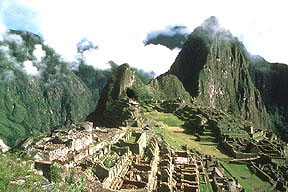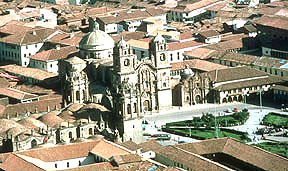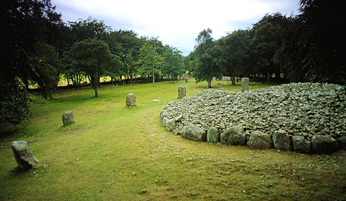A diagram showing how the Sun moves through the sky on an equinox.
Click on image for full size
The Vernal and Autumnal Equinoxes
We're still pretending that you're the person standing on the Earth in
the picture to the left, living in Topeka, Kansas, around 40° N latitude. The picture on the left shows the view
from the solar system (upper panel), and from on the surface of the
earth (lower panel). Notice that some of the same features are
labelled on each panel. In the upper panel, the Earth's axis is
pointing into your computer screen.
The upper panel shows that on an equinox (which occurs around March
and September 21), neither half of the Earth points directly towards
the Sun. In fact, the Sun is at the equator, so both halves of the
Earth are getting about the same amount of sunlight. For you in
Topeka, the altitude of the Sun is about
50°, in between its altitude on the solstices. The bottom panel
shows how this looks to someone standing on the ground in Topeka.
Equinox literally means "equal night". On the vernal (spring) and
autumnal (fall) equinoxes, day and night are nearly the same length (the date on which day and night are actually closest to the same length is called the equilux, and occurs a few days towards the winter "side" of each equinox). Neither
hemisphere gets more sunlight than the other, so both have similar seasons
(fall in one hemisphere and spring in the other).
How high the Sun gets in your sky, and how long it is above the
horizon during the day, depend not only on the season, but also on
your latitude.
You might also be interested in:

Peru's new president, Alejandro Toledo, was sworn in on July 28, 2001. The next day he visited Machu Picchu and Cuzco. There were ceremonies at both locations where Toledo asked for the blessing of the
...more
Cuzco is located in Southern Peru. It is the ancient capital of the Inca Empire. It is the oldest, continuously occupied city in the Americas. In ancient times, Cuzco was the ceremonial capital and hub
...more
People from Asia crossed the Bering Strait into North America. These people were first in this new land and so they are known as Native Americans. Over time, these people broke into tribes (as seen on
...more
"The movements of the heavenly bodies are an admirable thing, well known and manifest to all peoples. There are no people, no matter how barbaric and primitive, that do not raise up their eyes, take note,
...more
The stones of Carnac, France, are probably the most famous stones markings outside of those found at Stonehenge in England. There are many, many stones at Carnac. And these stones are very old too, the
...more
Not too far from Loch Ness, there lies three giant tombs made of stones. They are called the Balnuaran of Clava. The Balnuaran of Clava, giant tombs encased in stone, can be found close to Inverness in
...more
The stone structures of England and France are very famous. In Italy, you'll also find standing stones, stone rings, and stone tombs. An example of these stone structures is in Fossa, Abruzzo, in Italy.
...more















